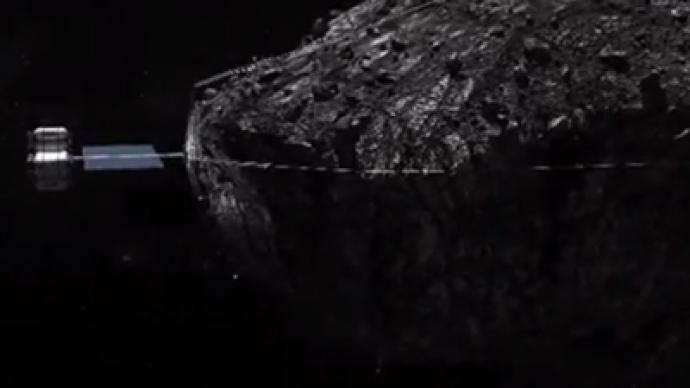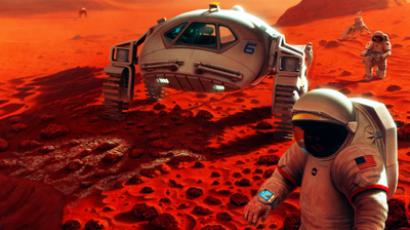Private company plans to mine asteroids and manufacture products in space

The days of dreaming about space rock retail goods might not be too far away: a new start-up company from California plans to mine asteroids in order to make products for consumers that are literally out of this world.
During a press conference held Tuesday in Santa Monica, CA, Deep Space Industries announced plans to put a fleet of small asteroid-mining spacecraft into orbit. The group says they wish to get the project off the ground by 2015, and by the end of the decade they hope to have an arsenal of vehicles floating through space, scooping up asteroids to be used for manufacturing. With the help of high-tech 3D printers and state-of-the-art technology that has suddenly become more affordable than ever, DSI hopes to be among the first of new companies that aims to make asteroid rocks all the rage.
“My smartphone has more computing power than they had on the Apollo moon missions,” DSI Chairman Rick Tumlinson said during this week’s announcement. “We can make amazing machines smaller, cheaper and faster than ever before.”“Using low cost technologies, and combining the legacy of our space program with the innovation of today’s young high tech geniuses, we will do things that would have been impossible just a few years ago,” he said, calling his project, “the first commercial campaign to explore the small asteroids that pass by Earth.”Just last year, Planetary Resources, Inc. announced similar plans to put spacecraft into the sky and scope out precious metals to be used in manufacturing. “The resources of Earth pale in comparison to the wealth of the solar system,” the company’s co-founder said at the time.
But while Planetary Resource’s idea has failed to come to fruition just yet, DSI’s staffers seem optimistic that a second company in the market for mining atmospheric rocks might finally jumpstart an all new race to space."One company may be a fluke," Tumlinson said at Tuesday’s conference. "Two companies showing up, that's the beginning of an industry.”DSI hasn’t announced exactly how much money it has to fund its project, or where it’s coming from, but has revealed other information about the 55lb “FireFly” spacecraft and what each one will be capable of doing while out in orbit. Equipped with MicroGravity Foundry 3D printers, DSI says their fleet of FireFly craft will be able mine precious rock and use the resources to make retail goods.
“The MicroGravity Foundry is the first 3D printer that creates high-density high-strength metal components even in zero gravity,” DSI co-founder Stephen Covey says in a statement. “Other metal 3D printers sinter powdered metal, which requires a gravity field and leaves a porous structure, or they use low-melting point metals with less strength.”“Using resources harvested in space is the only way to afford permanent space development,” added DSI CEO David Dump. “More than 900 new asteroids that pass near Earth are discovered every year. They can be like the Iron Range of Minnesota was for the Detroit car industry last century – a key resource located near where it was needed. In this case, metals and fuel from asteroids can expand the in-space industries of this century. That is our strategy.”According to NBC News, FireFlies will ideally go into orbit in 2014, with three-to-four-year missions carried out by the slightly larger DragonFly craft coming the following year. Each one of those missions, claims DSI, will allow for up to 100 pounds of asteroids to be brought back to Earth.“This is the Deep Space mission – to find, harvest and process the resources of space to help save our civilization and support the expansion of humanity beyond the Earth – and doing so in a step by step manner that leverages off our space legacy to create an amazing and hopeful future for humanity,” said Tumlinson.The risks of asteroid mining are formidable, but the reward may be exponentially higher. A study released by the Keck Institute for Space Studies (KISS) at the California Institute of Technology in Pasadena last April estimated the price tag of moving an asteroid weighing 500,000 kilograms to a high lunar orbit by 2025 at around $2.6 billion.But with thousands of Near Earth Asteroids (NEA) with an estimated worth ranging between $1 billion and $25 billion, Planetary Resources announced the same month that the growth of the asteroid capture and return industry could “add trillions of dollars to the global GDP.” The next great frontier of free market expansion has attracted such notable backers as movie director and explorer James Cameron, who has joined Planetary Resources’ foray into the space age gold rush. Google’s billionaire co-founder Larry Page, executive chairman Eric Schmidt, director K. Ram Shriram, and the chairman of Perot Systems, Ross Perot, Jr., are also notable financiers of the project.12BF Global Ventures, a Russian investment firm that deals primarily with alternative energy, further announced its intentions to invest $50 million in the space industry in August. 12BF confirmed they had invested an undisclosed investment in Planetary Resources that will be carried out in several stages.With Deep Space Industries throwing their hat in the ring, the next great space race is set to heat up.














